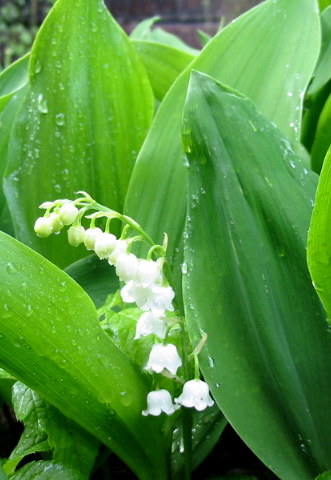
Image: Muguet by Guerlain (from Diane James homepage)
As I mentioned in my previous entry, the lily-of-the-valley odour in perfumery is made from the synthetic materials. Hydroxycitronellal is known in perfumery since the beginning of the former century. But how did perfumers make the muguet note before the synthetic era when almost all perfumes were made of naturals?
What naturals can imitate the smell of lily-of-the-valley? Well, jasmine smells close. And some perfumers mention that diluted ylang-ylang oil smells like muguet as well. I have tried a 1% solution of ylang-ylang oil in alcohol and indeed it has a resemblance with lily-of-the-valley. Cardamom is another ingredient used in muguet formulae.
Here is an example of lily-of-the-valley formula from an apothecary magazine from 1892:
Extract of jasmine – 200 g
Extract of ylang-ylang – 100 g
Alcohol 95% – 200 g
Powdered cardamom – 5 g
After two days of maturation of cardamom powder in alcohol solution of jasmine and ylang extracts, the blend becomes to achieve the resemblance with lily-of-the-valley odour.
Extracts are probably the alcohol tinctures of fragrant materials. For flowers it would probably be the pomade. But may be the ylang-ylang extract can be substituted by essence (a alcohol solution of ylang-ylang oil). I haven’t tried this formula yet, but would give it a chance as soon as I get the jasmine pomade to make an extract.
As I mentioned in my previous entry, the lily-of-the-valley odour in perfumery is made from the synthetic materials. Hydroxycitronellal is known in perfumery since the beginning of the former century. But how did perfumers make the muguet note before the synthetic era when almost all perfumes were made of naturals?
What naturals can imitate the smell of lily-of-the-valley? Well, jasmine smells close. And some perfumers mention that diluted ylang-ylang oil smells like muguet as well. I have tried a 1% solution of ylang-ylang oil in alcohol and indeed it has a resemblance with lily-of-the-valley. Cardamom is another ingredient used in muguet formulae.
Here is an example of lily-of-the-valley formula from an apothecary magazine from 1892:
Extract of jasmine – 200 g
Extract of ylang-ylang – 100 g
Alcohol 95% – 200 g
Powdered cardamom – 5 g
After two days of maturation of cardamom powder in alcohol solution of jasmine and ylang extracts, the blend becomes to achieve the resemblance with lily-of-the-valley odour.
Extracts are probably the alcohol tinctures of fragrant materials. For flowers it would probably be the pomade. But may be the ylang-ylang extract can be substituted by essence (a alcohol solution of ylang-ylang oil). I haven’t tried this formula yet, but would give it a chance as soon as I get the jasmine pomade to make an extract.





